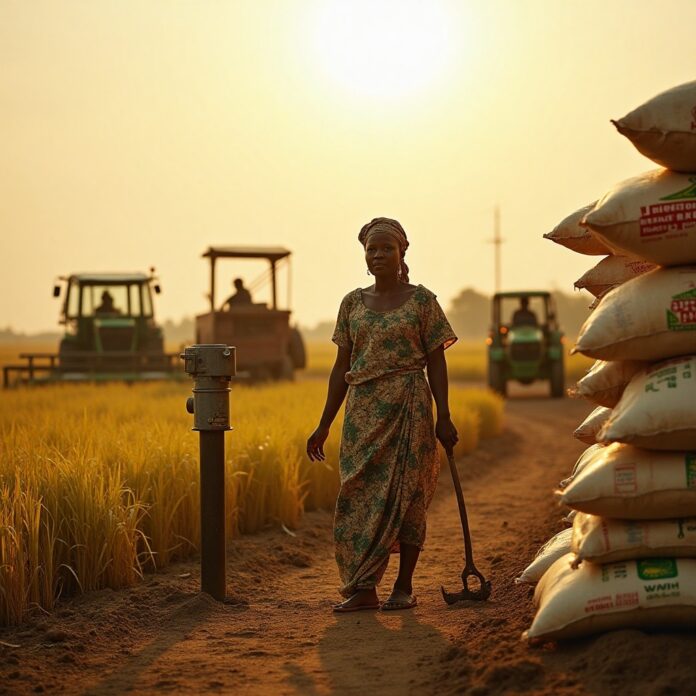Kebbi State, often dubbed “Nigeria’s Rice Bowl,” plays a pivotal role in the country’s quest for food security. With annual production exceeding 1.5 million metric tons at its peak, the state employs over 2 million smallholder farmers. Yet, beneath this success lie pressing challenges: erratic irrigation, outdated harvesting tools, and fierce competition from imported rice brands. Let’s dissect these issues—and their solutions—through the lens of practicality and resilience.
🏗️ BuildNaija Expo 2025!
🗓️ May 30-31 | Online Event via Google Meet
Irrigation Challenges in Kebbi’s Rice Farms
The Water Dilemma
Kebbi’s rice fields traditionally rely on flooding and seasonal rains from the River Niger. But climate change has upended this rhythm. Droughts, erratic rainfall, and falling river levels leave farmers vulnerable. Imagine tending a 20-hectare farm, only to watch crops wither because the rains arrive late—or not at all. This is the stark reality for many in Bagudu, Argungu, and Suru.
Government Interventions: Hits and Misses
The Anchor Borrowers’ Programme (ABP), launched in 2015, initially revolutionized Kebbi’s irrigation. Farmers received pumps, seeds, and fuel subsidies, catapulting production from 200 metric tons to 1.5 million tons by 2017. But sustainability faltered. Broken pumps, silt-clogged canals, and soaring fuel costs plagued progress. A farmer in Zuru lamented, “Solar pumps saved my harvest, but getting one felt like winning the lottery.”
Solutions in Sight
- Solar Power: Kebbi’s 2023 partnership with the World Bank aims to distribute 5,000 solar-powered pumps by 2025.
- Farmer Training: Workshops on Alternate Wetting and Drying (AWD) techniques reduced water use by 30% in pilot farms.
- Infrastructure: The Kebbi State Irrigation Development Project (KSIDP) rehabilitated 120km of canals in 2023, though delays persist.
Key Takeaway: Irrigation fixes demand consistent investment—not one-off projects.
Harvesting Tools – Bridging the Traditional-Modern Gap
The Backbreaking Reality
Picture rows of farmers bent double under the sun, swinging sickles. Manual harvesting dominates here, but labor shortages during peak seasons lead to 30% post-harvest losses. A woman farmer in Argungu sighed, “We lose grains because we can’t cut fast enough.”
🏗️ BuildNaija Expo 2025!
🗓️ May 30-31 | Online Event via Google Meet
Machinery: A Double-Edged Sickle
Kebbi’s push for mini-combine harvesters (e.g., Tak Rice Harvester) and reapers is promising. Yet, a ₦4 million price tag for a mini-harvester remains out of reach for smallholders earning ₦60,000 per 50kg bag. “It’s like asking us to buy a private jet,” joked a farmer in Yauri.
Bright Spots in Mechanization
- Cooperatives: Lababatu Usman Kamba, a 20-hectare farmer, pooled resources with neighbors to rent a harvester, slashing losses. “Now, I finish harvesting in days, not weeks,” she said.
- Government Schemes: Kebbi’s tractor rental program subsidizes costs by 40%, but accessibility remains uneven.
Key Takeaway: Mechanization isn’t just about machines—it’s financing models, repair networks, and mindset shifts.
Competing with Imported Brands – Kebbi’s Uphill Battle
Quality vs. Grit
Many Kebbi farmers still sun-dry grains on highways, leading to stones and dirt in final products. A Kano trader admitted, “Customers complain our rice ‘bites back.’” Modern mills like Amana Rice in Sokoto—processing 320 tons daily with laser sorters—could bridge this gap, but only 15% of Kebbi’s rice is machine-milled.
🏗️ BuildNaija Expo 2025!
🗓️ May 30-31 | Online Event via Google Meet
Branding: The Ofada Rice Playbook
Learn from Ofada Rice, a Southwest Nigerian success story. Startups like Labana Rice are replicating this by branding Kebbi’s grains as “Gold from the Niger,” packaged in calico bags with profiles of women farmers. Sales surged 200% in 2023. Founder Aisha Jega noted, “People don’t buy rice; they buy trust.”
The Smuggling Menace
Despite progress, porous borders undercut gains. In 2022, Nigeria seized 4.7 million bags of smuggled rice—enough to feed Kebbi for a year. A Katsina customs officer confided, “For every truck we stop, three slip through at night.”
Key Takeaway: Competing requires a trifecta—quality control, emotional branding, and policy muscle.
🏗️ BuildNaija Expo 2025!
🗓️ May 30-31 | Online Event via Google Meet
Integrated Solutions for Kebbi’s Rice Sector
- Tech Integration: Apps like Farmcrowdy provide real-time weather and price data.
- Cooperatives: Bulk purchasing of inputs cuts costs by 25%.
- Case Study: The Kebbi-Lagos Rice Partnership links farmers directly to urban markets, bypassing middlemen.
Cultivating Resilience
Kebbi’s path to rice sovereignty hinges on merging old wisdom with new tools. Solar pumps must complement River Niger’s legacy; harvesters should coexist with hand hoes. As Musa, a 62-year-old farmer in Bagudu, put it: “My father grew rice here. My sons will too—but smarter.” The stakes are high, but so is the grit.
Kebbi isn’t just growing rice; it’s sowing the seeds of a food-secure Nigeria. Let’s nurture that harvest.




